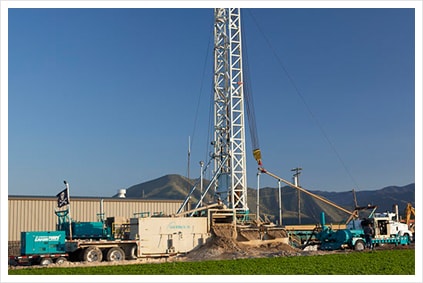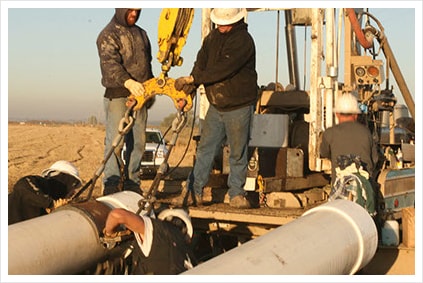WELL CONSTRUCTION
We use modern, well-maintained equipment
At Eaton Drilling Co., LLC. we custom engineer each well to meet the needs of the customer given the subsurface geology of the location. From the test phase, information from descriptive and geophysical logs as well as test hole cutting samples indicate the depths and composition of water-bearing formations specific to the site, so that the cased well can be constructed accordingly. Our experienced crews use modern, well-maintained equipment, and typically work in alternating shifts around the clock to maintain the best conditions for drilling and to complete jobs quickly.
Borehole Reaming
After completion of the design and its approval by the customer, the construction process begins by reaming out the test hole to a larger diameter past all production zones included in the well design. Depending on the subsurface lithology of the location, we use one of two available drilling methods to perform borehole reaming: direct circulation and flooded reverse circulation.
Casing
Casing is the primary structural component of water wells. Inside, it provides an open volume for underground water to collect and be removed. During construction, casing is lowered down the borehole in 10’ to 20’ sections, with each section fastened onto the one below it. The result is one long continuous tube. Typically, we position perforated casing in depth ranges surrounded by water-bearing formations to allow formation water to enter. Gravel pack occupying the volume between the outside of the casing and the borehole boundary (the annulus) prevents formation water from entering too quickly that would otherwise accelerate erosion of the surrounding production zones. Desired production rates, as well as the subsurface geology of the site, determine casing selection in terms of diameter and perforation configuration.
Gravel Pack
We select gravel pack material to match the particle size distribution of grains comprising water-bearing formations surrounding the well. Equivalent size-composition of the gravel pack regulates the entrance velocity of surrounding formation water into the casing, which greatly reduces erosion of surrounding formation solids. During construction, borehole drilling fluid must be less dense than grains of the gravel pack material so that it can settle to the bottom of the borehole, and fill upward, under the force of gravity. To ensure proper placement of the gravel pack, temporary tremie pipe is installed in the annulus--and sequentially removed during the process--to direct the downward flow of gravel to the top of the gravel pack as it fills. Since the annulus at the bottom of the well is relatively tight, small amounts of unwanted material settled at the bottom can greatly impede water intake if casing perforations are located there. Boreholes for our wells are typically completed 20’ below the deepest production zone so that settled debris can collect underneath the deepest intake perforations.


Eaton Drilling Co LLC in Woodland, Contractor license (133783), General Contractor, C-57 Well Drilling and C-61 Specialty services in California, also other trades Nevada and Oregon. Our equipment conforms to current air quality standards.
Address: 20 West Kentucky Ave, Woodland Ca 95695/ PH: 530.662.6795